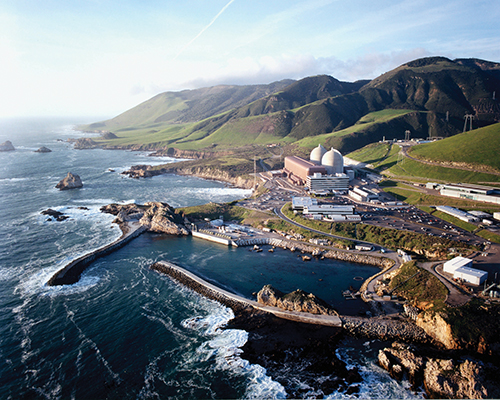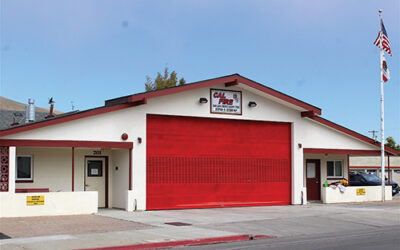This aerial photo of the Diablo Canyon Nuclear Power Plant shows the intake cove in the center and Diablo Cove [the outfall] directly above that. Photo courtesy PG&E
For the first time since it opened, the Diablo Canyon intake cove needs maintenance dredging, and the Coastal Commission was expected to green-light a project to get the work done.
But a Pacific Gas & Electric spokeswoman said the company pulled the item at the last minute from the Commission’s Oct. 13 agenda and plan to bring it back next spring.
Nevertheless, commission staff had recommended the board approve the project, proposed by plant owner PG&E. No reason was given for why the company pulled the item, especially since the staff recommended approval. (Barring a significant change in the law or some other concern arising, the recommendation should again be for approval when it comes back.)
PG&E, the report said, “proposes to dredge approximately 70,000 cubic yards of shoaled sediment from the Diablo Canyon Power Plant seawater intake cove. This will be the first dredging episode to maintain the intake system since the DCPP went into operation in 1985.”
And if PG&E were going to close the plant, as it had proposed to do by 2025, the dredging probably wouldn’t be happening. But the State and Federal Governments have both urged the plant stay open perhaps for as long as 10 years, or more, in order to support the state power grid with its reliable, 2,200 megawatts of power.
In a plant this size, all aspects of the operations must be maintained to a level where they don’t hamper the overall performance of the plant.
“PG&E has determined,” the report said, “that sediment buildup in the intake cove poses a substantial risk in the near term to the operations of the DCPP’s seawater intake equipment, which cycles 2.5-billion gallons of seawater each day for cooling.
“PG&E has observed sediment in equipment,” the report continued, “and increased kelp and algal growth in the intake cove, which it is concerned increases the risk of an inadvertent shutdown and interferes with divers performing critical maintenance of the intake structure.”
The recommendation was to approve the permit for the dredging, but getting permission to dredge is only half the battle, as one still has to figure out where to put the spoils. The company plans to use a site off Montaña de Oro that’s been approved to take the spoils from the annual dredging of the Morro Bay Harbor entrance.
“Once collected,” the report said, “dredged sediment would be transported by barge and placed offshore of the Morro Bay Sandspit at the U.S. Army Corps of Engineers’ near-shore placement site, approximately 1,300 to 2,500-feet offshore. The near-shore placement area is located approximately 13-miles from the dredge site and PG&E proposes to transport dredged sediment there roughly five times per day over the approximately 7-day period of proposed dredging.”
Such maintenance projects have some issues under the State Coastal Act, but the Commission’s involvement is limited.
“The key Coastal Act issues raised by this proposed project and within the Commission’s jurisdiction,” the report said, “relate to potential adverse impacts to marine biological resources due to dredging and placement operations and potential water quality impacts from turbidity generated during dredging.”
In essence, dredging the sea floor, even in a man-made harbor like Diablo Canyon, will unavoidably also suck up sea creatures that live in that muck. And the dredge materials are supposed to be compatible with the seafloor at the disposal site, in other words, you can’t dredge up a bunch of sticky mud and dump it on pristine sea floors, like reefs.
The Army Corps of Engineers (ACOE), many years ago, studied this and other issues when it committed to maintain a depth of some 40 feet at the harbor entrance, and tame some of the breaking waves that have made the bar infamous on the West Coast.
The ACOE won approval to use this site off Montaña de Oro to dump spoils dredged up by the dredge ship, Yaquina, which visits Morro Bay every year around early June.
The site study looked for places with no reefs and just sandy bottom, which describes much of the Estero Bay seafloor.
Water depth had to deep enough to ensure the spoils scattered with the current and spread out over a larger area.
The Commission proposed several special conditions on the project, including limiting the work to just the area outlined in the application; and PG&E must submit a post-project “bathymetric survey of the dredge footprint and provide the final placement volume.”
The commission staff also conditioned the coastal development permit to “reduce potential impacts to water quality and biological resources within the intake cove.”
Dredging not only sucks up sediments it stirs up the water considerably, which increases turbidity and degrades water quality if only for a little while until the water calms back down and sediments settle out once again.
The paperwork is going to be a chore. The CCC wants a “Turbidity Monitoring Plan, a Biological Resources Monitoring Plan, a Marine Wildlife Contingency Plan, and an Oil Spill Prevention and Response Plan,” required by the permit.
And the commission also wants PG&E to have all other necessary permits in hand — from any state and federal agencies involved — before starting work. The Commission also wants the permit to come back to them, “if project changes are required as a result of those authorizations.”
Diablo intake cove is a relatively small, protected, man-made harbor. At one end is the plant’s seawater intake tunnel, where the plant brings in cold seawater to cool steam back down in the plant’s “once-through cooling” system.
The warmed cooling water is discharged at Diablo Cove, which is just up the shoreline from the intake cove entrance and which is open to the ocean.
That warmed-up discharge water has been blamed in the past for changing the array of sea creatures inhabiting Diablo Cove. PG&E paid millions in fines to the Regional Water Quality Control Board, some of which was used to start the Morro Bay National Estuary Program back in the mid-1990s, for so-called “thermal” impacts to the environment.
The intake structure and once-through cooling are actually banned by the State Water Resources Control Board, which had ordered all nuclear plants to cease once-through cooling by 2020.
That deadline was set aside after PG&E announced it would not seek to re-license the two reactors and instead shutter them when the current licenses run out, in 2024 and 2025.
But the State and Federal Governments decided that they needed the plant’s reliable 2,200 MW of energy to help support the power grid, at least until they’ve built enough alternative energy plants — wind and solar — to ensure grid reliability.
PG&E has since begun the re-licensing process all over again through the Nuclear Regulatory Commission or NRC, the federal agency that oversees the licensing and monitoring of nuclear power plants and other facilities in the U.S.
Meanwhile, the company is moving forward with planning for the eventual closure and decommissioning on a somewhat parallel path to re-licensing.



